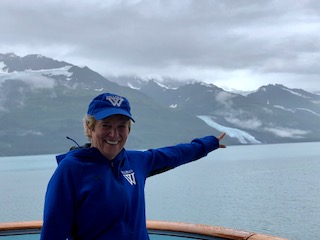A Wonder of Ice and Snow: Alaska’s Wellesley Glacier

In 1899, a physician diagnosed New York railroad tycoon Edward Henry Harriman with work exhaustion. The prescribed cure was simple: a long vacation. Not one disposed to modest rest and relaxation, Harriman began organizing a family hunting and adventure expedition to Alaska that soon expanded into one of the most famous exploratory and scientific missions of the 19th century.
The Harriman Expedition set sail off the coast of Seattle, traveling 9,000 miles round-trip to Siberia, then back. On board the steamer George W. Elder were Harriman’s family, friends, and an elite team of leading scientists, artists, and writers, including Clinton Hart Merriam, first head of the U.S. Biological Survey and one of the founders of the National Geographic Society; John Muir, glacier expert, naturalist, and co-founder of the Sierra Club; nature essayist John Burroughs; and Harvard mineralogist Charles Palache.
As it coincided with the Alaska gold rush, the New York Times dubbed the well-publicized, two-month expedition the “American Eldorado.” Rather than gold, however, the scientific team returned with more than 100 trunks full of specimens and over 5,000 photographs and colored illustrations. The trip yielded enough data to fill 12 scientific volumes published during the next 12 years.
Among the expedition’s most important accomplishments were the mapping and naming of previously uncharted, or mischarted, fjords and glaciers. On June 26, 1899, the George W. Elder arrived in the northern part of Prince William Sound, home to the world’s most active tidewater glaciers (flowing from a mountain valley into the sea). The scientists christened the area the College Fjord and named the glaciers comprising it after their alma maters and their sister schools, including Wellesley, Amherst, Harvard, Barnard, Bryn Mawr, Smith, and Yale.
Wellesley Glacier, located on the western bank of the fjord, is a four-mile-long tidewater glacier. In the words of Muir, it is among “the finest and wildest of [its] kind, looking, as [it] comes bounding down a smooth mountainside through the midst of lush flowery gardens and goat pastures, like tremendous, leaping, dancing cataracts in prime of flood.”
 This past summer, Connie Bauman capped 39 years of service to Wellesley as physical education and sports medicine professor and director of employee wellness with an Alaskan cruise, during which she visited Wellesley Glacier. The recent retiree said she “had no idea that there was a glacier named for Wellesley prior to [the] trip,” but learned during a tour lecture that the Seven Sisters schools had glaciers named in their honor, as well as Harvard and Yale— “Of course, Wellesley’s glacier was the most spectacular!"
This past summer, Connie Bauman capped 39 years of service to Wellesley as physical education and sports medicine professor and director of employee wellness with an Alaskan cruise, during which she visited Wellesley Glacier. The recent retiree said she “had no idea that there was a glacier named for Wellesley prior to [the] trip,” but learned during a tour lecture that the Seven Sisters schools had glaciers named in their honor, as well as Harvard and Yale— “Of course, Wellesley’s glacier was the most spectacular!"
Bauman encourages those with an interest in seeing Alaska’s wilderness—and Wellesley’s remarkable namesake—to visit the glaciers in the comparatively milder summer months, and if possible, soon. Like other glaciers worldwide, the College Fjord glaciers are receding.
Photo: Wellesley Glacier, center, runs four miles down the western shore of College Fjord.
Photo(inset): Connie Bauman points out Wellesley Glacier while on an Alaskan cruise in Summer 2018.



